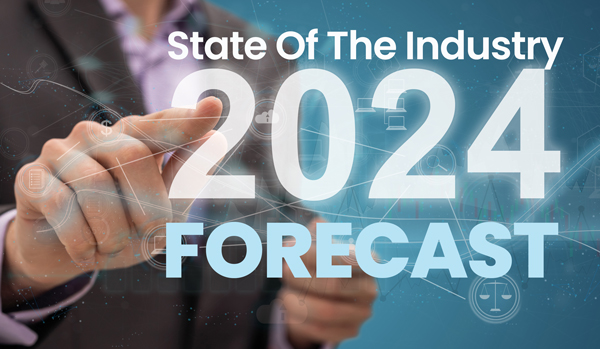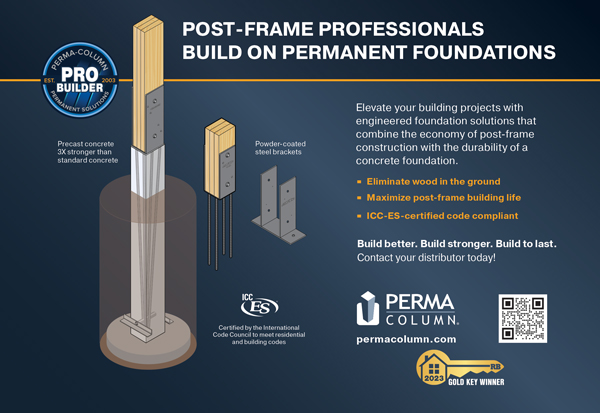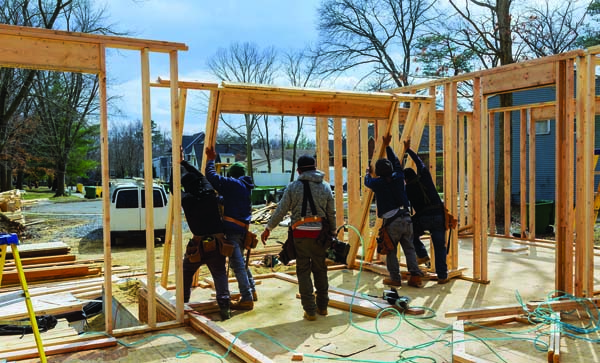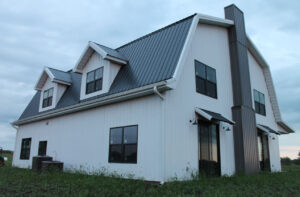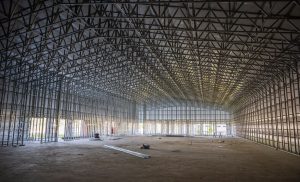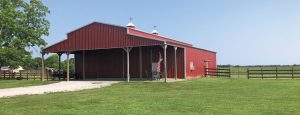By Linda Schmid
As most everyone in business is aware, the economic situation can have a big impact on profitability, whether it’s local, national, or across the industry or niche in which you are invested. Of course, everyone wants to know what is coming so they can prepare, but alas … our crystal balls often fail us. While no one can predict the future with complete confidence, some are better at recognizing the trends and offering realistic insights; we will begin our inquiry with them.
The Economists
Economist Anirban Basu regularly reviews the state of the economy and its likely impact on the construction industry. He has provided a mixed outlook for 2024.
“The upcoming year will present varied challenges and opportunities for contractors,” Basu said. “Contractors focusing on public works are poised for a successful year thanks to increased funding from infrastructure legislation, while those working on residential properties will likely see a shore up of projects due to a tough real estate market.”
In other words, with high prices and lower supply than demand, residential construction isn’t likely to slow down. Further, Basu sees growth opportunities in mega-projects across the country as many manufacturers reshore supply chains. These projects will call for more employees in an industry that already offers more job opportunities than skilled/quality workers to take them.
When considering what situations may negatively affect peoples’ plans to build, Basu advises remembering these: high consumer debt, geopolitical uncertainty, stricter credit conditions, and the government’s increasing debt. However, he believes that the bond market indicates a likely decline in interest rates by mid year. If this occurs, it could mean greater project financing and backlog generation.
Ken Simonson, Chief Economist of the Associated General Contractors of America, said that after a torrid third quarter in 2023, slower growth is expected going into 2024. Overall, he believes that unemployment will remain low.
“Some industries will cut headcount, but most people who want jobs will find them quickly,” Simonson said. “Conversely, employers in expanding industries such as construction, will continue to have trouble filling positions,” he said, “and will have steadily increasing wage bills for new workers (when they can find them) and overtime or bonuses.”
Simonson said that while most supply chain issues have been cleared up, there remain a few holdouts, such as electrical equipment and it looks like these will likely remain problems throughout 2024. He expects these supply challenges along with labor shortages will stretch project completion times.
Specific niches that Simonson expects to do well in 2024 are data centers and manufacturing plants followed by infrastructure and renewable energy projects.
The Survey Says
Shield Wall Media conducted an industry survey to gauge how industry insiders see things.
Overall, our responses show optimism. Respondents indicated that over 70% believe that the general business climate will improve or stay the same. When you look at what market segments predict for their own markets there are some differences.
The commercial segment is perhaps the most optimistic with nearly 50% expecting the segment to grow and close to 40% expecting it will stay the same.
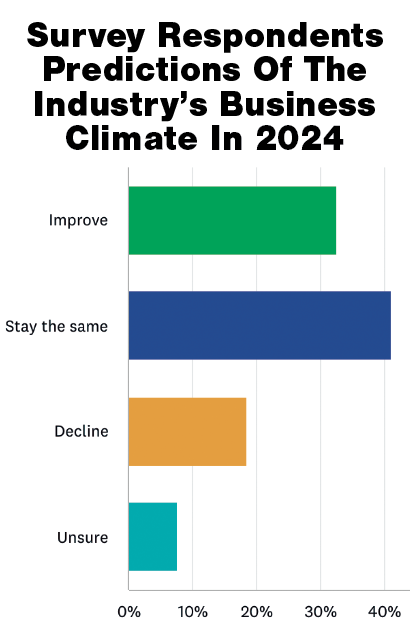
The industrial segment is close behind with over 40% believing work will increase in ’24, while over 50% say it will stay the same.
In the ag building community, the expectation of over 60% is that work levels will stay the same, and the residential segment most closely resembles overall industry expectations.
Industry Professionals Report
Chris Davis of Dripstop® views the business climate very positively.
“The industry continues to be surprisingly strong despite higher interest rates making debt financing more expensive,” Davis said. “We expected a slowdown that never actually came. I think we were all kind of waiting for the ball to drop, but order books have thus far remained full.
“Demand has actually been better than pre-pandemic levels. We ask regularly and generally customer confidence is high.”
Brett McCutcheon of Beck America reported that the market is strong and they expect business profitability in 2024 to be good, similar to 2023.
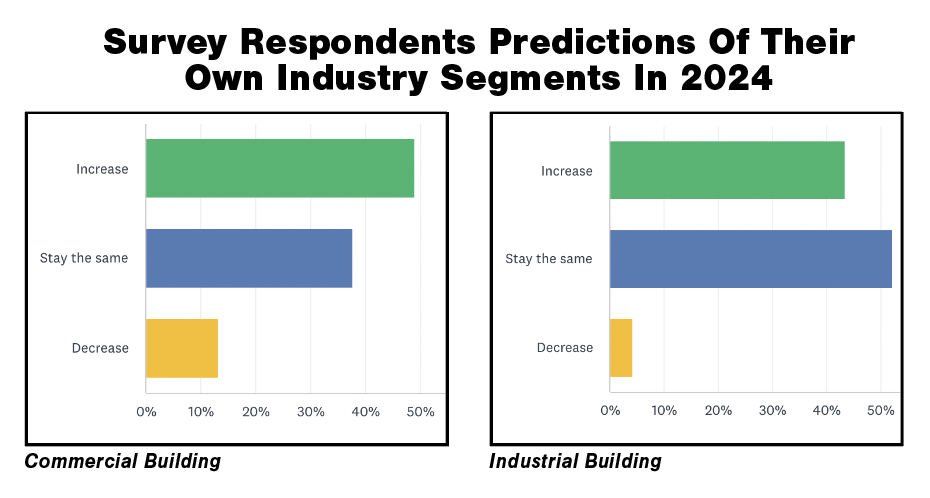
Jason Myrvik of Midland Door Solutions indicated that they are doing better than pre-pandemic levels and he expects that to continue into 2024.
“We are seeing a significant increase in the ag sector with new shops and machine sheds,” Myrvik said. “Aviation is another sector that shows promise with the amount of federal funds available for local airports to build new hangars or repair existing facilities. I can only assume that the commercial sector will weaken with the rise in interest rates.”
Davis agreed that the ag sector has been strong. He continued, “Due to the long, positive self-storage growth curve, we are always a bit afraid of when supply will exceed demand.”
Levi’s Mike O’Hara said, “We are seeing growth in the core markets of post frame, metal building, and residential roofing. Residential re-roofs are strong, and we believe the metal market continues to take share from shingles. The agriculture market/pole barns continue to grow also.”
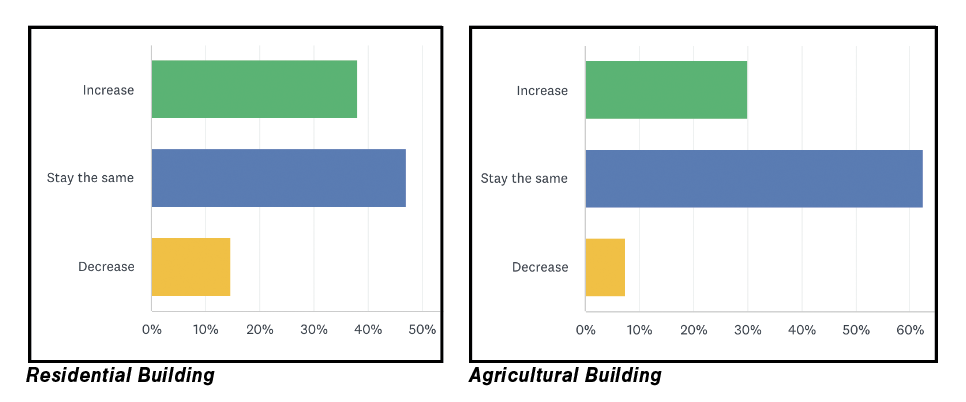
Much talk is centered around beliefs that residential building will be strong because there is not enough housing. However, O’Hara points out that new permits continue to be at low levels compared to 5+ years ago.
“One reason may have to do with higher interest rates, but they are still historically low compared to the 1980s,” O’Hara said. “Multi-family housing (apartments/townhomes/condos) continue to gain in popularity as some want maintenance free living, and others can’t save enough for a down payment given the fact that housing prices have risen so much over the past 5-10 years. Lastly, people are living longer and staying in their homes longer.
Of course, every year has business challenges, and Davis expects that interest rates will be the biggest challenge in 2024.
Myrvik said, “We are seeing an increase in component costs. Steel costs are on the rise again with no sign of leveling off.”
Myrvik believes that pricing will not return to pre-pandemic levels and the higher prices will be the new norm.
McCutcheon expects the obstacle themes in 2024 will be inflation, finding employees, and the cost of materials and interest rates in that order.
The employee deficit is now a thorn in the sides of companies across the industry. Myrvik, McCutcheon, and Davis agree that will likely continue.
Myrvik said, “The labor shortage is not just in our industry — it seems to be a problem across the board, for everyone you speak with. We’ve started the recruiting process early,” he added, “with high schools and technical schools to educate the students about what we do in hopes that when they graduate, they will want to join our team.” RB


